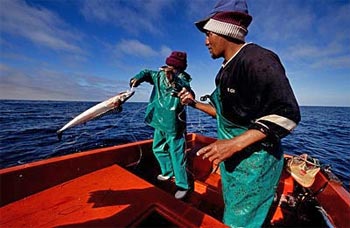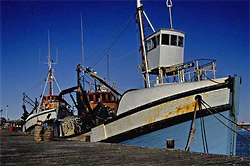ANGOLA, NAMIBIA AND SOUTH AFRICA JOIN HANDS IN A COMMISSION TO MANAGE OUR MARINE ENVIRONMENT
 The idea sounds straightforward. We have one common marine environment endowed with rich and commercially valuable fish stocks that straddle across the political borders of Angola, Namibia and South Africa. Fishers in all three countries rely on these same resources. Overfishing in one country will affect the transboundary fish populations, thus affecting fishers in the other countries. Should the three countries not join hands to manage the marine resources then? The idea sounds straightforward. We have one common marine environment endowed with rich and commercially valuable fish stocks that straddle across the political borders of Angola, Namibia and South Africa. Fishers in all three countries rely on these same resources. Overfishing in one country will affect the transboundary fish populations, thus affecting fishers in the other countries. Should the three countries not join hands to manage the marine resources then?
By the same token, when invasive alien species are introduced via the ballast water of ships, when there are harmful algal blooms, or when pollution results from economic activities in the marine and coastal area, the negative impacts can spread across countries affecting the entire marine environment. Should Angola, Namibia and South Africa not strive to harmonise rules and policies to ensure a healthy marine environment then?
 The idea of a common management system for our region was thus born. In fact, this is a general idea or principle that applies to the 64 Large Marine Ecosystems (LME) into which the world has been divided. The Benguela Current Large Marine Ecosystem (BCLME) that links Angola, Namibia and South Africa is one of them. An LME shares common characteristics in terms of hydrography, productivity, etc. Because an LME functions as one large system ecologically interlinked, actions taken in one country will affect the other countries flanked by the same ecosystem. The idea of a common management system for our region was thus born. In fact, this is a general idea or principle that applies to the 64 Large Marine Ecosystems (LME) into which the world has been divided. The Benguela Current Large Marine Ecosystem (BCLME) that links Angola, Namibia and South Africa is one of them. An LME shares common characteristics in terms of hydrography, productivity, etc. Because an LME functions as one large system ecologically interlinked, actions taken in one country will affect the other countries flanked by the same ecosystem.
It was to put this idea into practice in our region that the BCLME Programme was developed. Since 2002, this joint initiative by the three countries has been advancing scientific knowledge and building capacity for the joint management of our sea and coast. One of its major achievements was the creation of the Benguela Current Commission (BCC) in August 2006, when the three countries signed an interim agreement.
The signing of the interim BCC agreement
The BCC serves as an advisory body to the governments of the three countries. It is the formal structure that will put in place a stronger regional cooperation on regulatory, institutional and decision-making aspects relating to the Benguela region. It will also make the countries’ scientists join hands to monitor the conditions, contaminants and resources at risk within the LME.
 BCC’s decisions and results will trickle down to the coastal populations, the fishers, diamond miners, tourist operators and everybody that uses our rich coast. By agreeing to oversee our marine environment together through the BCC, the three countries are striving to keep it healthy and accessible in an equal manner to all. News about the BCLME Programme and the BCC will be regularly posted on DLIST, where we can all give our input to ensure that the management system is aligned with the local realities and needs along the coast. BCC’s decisions and results will trickle down to the coastal populations, the fishers, diamond miners, tourist operators and everybody that uses our rich coast. By agreeing to oversee our marine environment together through the BCC, the three countries are striving to keep it healthy and accessible in an equal manner to all. News about the BCLME Programme and the BCC will be regularly posted on DLIST, where we can all give our input to ensure that the management system is aligned with the local realities and needs along the coast.
The BCC will outlive the BCLME Programme, which will have funding from the Global Environment Facility (GEF) through the United Nations Development Programme (UNDP) only until March 2008. In the meantime, a new GEF project has already been proposed that is entitled “Implementation of the Benguela Current LME Action Programme for Restoring Depleted Fisheries and Reducing Coastal Resources Degradation”. Not only will it support the BCC, but also key governance mechanisms such as an Ecosystem Approach to Fisheries Management (EAF). All for the same goal of protecting our coast!
What to know more?
The BCLME Programme’s Kiosk on the DLIST portal is regularly updated with results, news and resources. The website of the BCLME Programme at www.bclme.org contains more detailed information about the Programme and a wealth of knowledge about the region’s resources and their management. For an overview of the BCLME region visit the Hotspots on the DLIST portal.
|